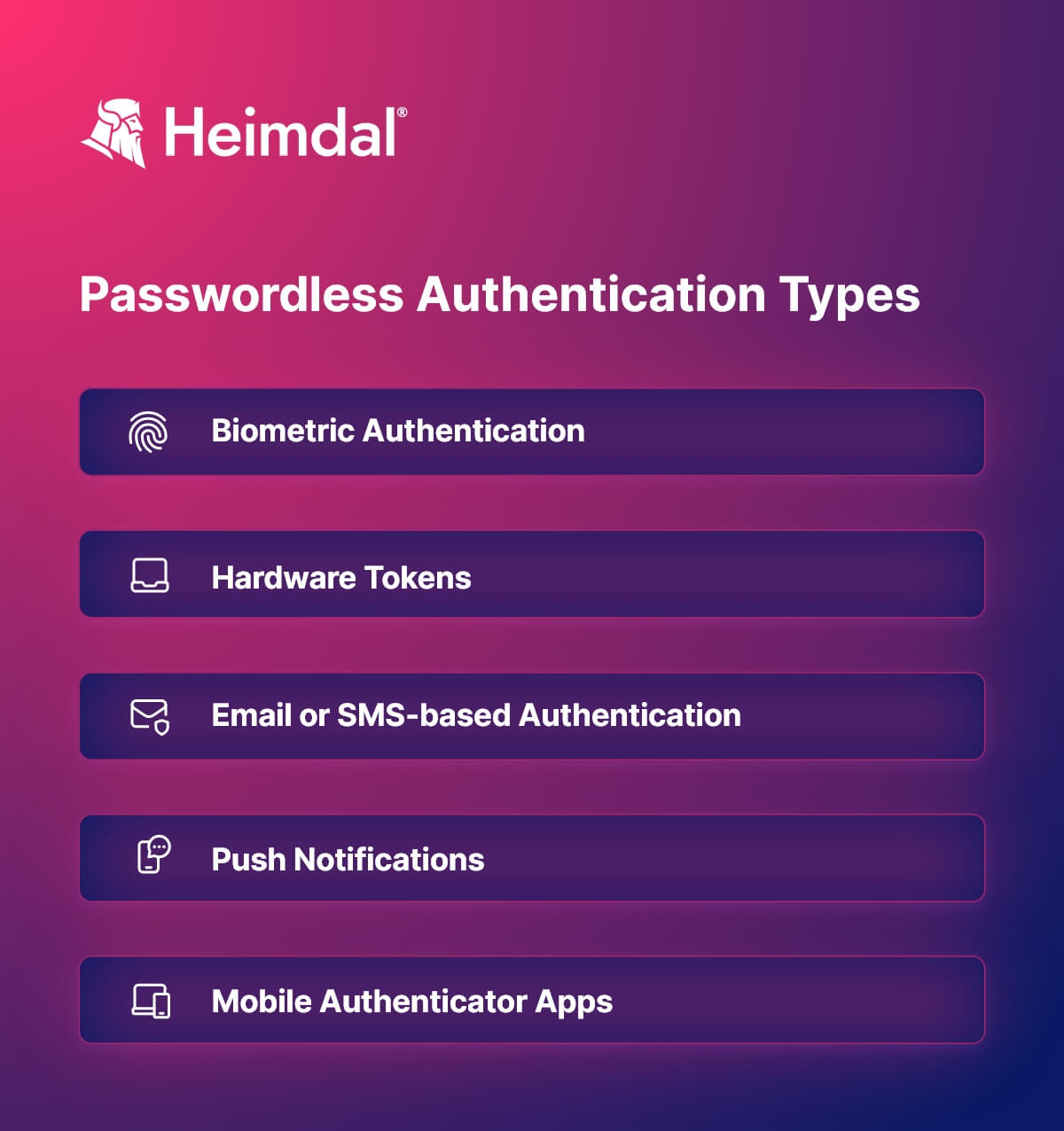Contents:
In today’s interconnected world, where cyber threats loom large, the traditional password-based authentication method has shown its limitations and ceased to provide adequate security. Passwords pose serious challenges as they are difficult to remember, often reused across different apps, and are prone to be easily misplaced, putting sensitive information at risk.
They are also massively targeted by cybercriminals. The more individuals rely on passwords, the more they become susceptible to attacks such as social engineering, phishing, and brute force attempts. In fact, according to Verizon’s 2022 Data Breach Investigations Report, 81% of hacking-related data breaches can be attributed to weak or stolen credentials.
As a result, a more secure and user-friendly authentication system has become critical. I present you the topic of this article: passwordless authentication – a revolutionary approach that does away with the need for passwords.
Passwordless Authentication Defined
Passwordless Authentication is a type of authentication that enables users to obtain access to an app or IT system without providing a password or responding to security questions. Instead, this method leverages a variety of authentication factors, such as biometrics, hardware tokens, push notifications, or one-time passwords (OTPs).
This authentication method is frequently used together with other authentication processes, such as Multi-Factor Authentication (MFA) and Single Sign-On technologies to improve user experience, bolster security, and reduce the cost and complexity of IT operations.
Passwordless Authentication Types

Here are some common types of passwordless authentication. Some of the methods listed below can be combined in order to offer multi-factor authentication for increased protection.
Biometric Authentication: This authentication method verifies a user’s identity using unique physical traits. It can include techniques like voice recognition, iris scanning, facial recognition, or fingerprint scanning. It’s true that certain biological features can now be spoofed thanks to modern AI, but behavioral traits are still very difficult to imitate.
Hardware Tokens: Hardware tokens are physical devices that create one-time passwords (OTPs) or cryptographic keys for authentication. These tokens can take the shape of USB devices, smart cards, or specialized key fobs. To authenticate, users normally need to have the token with them.
Email or SMS-based Authentication: During the registration process, users submit their email address or phone number. When authentication is required, the users receive a one-time code or link through a text message or email. To authenticate, users type the received code or access the link.
Push Notifications: This approach entails using a mobile app on an authorized smartphone. When authentication is needed, a push notification is sent to the user’s device. The user is then able to approve or decline the login attempt from their device.
Mobile Authenticator Apps: These applications create time-based one-time passwords (TOTP) or employ additional cryptographic techniques to ensure secure authentication. The app generates a unique code that changes at frequent intervals and is synchronized with the server. This code is entered by the user during the authentication process.
How Does Passwordless Authentication Work?
Passwordless authentication takes the place of traditional passwords and uses alternative methods to confirm the identities of users. During the registration process, users associate their accounts with an authentication method such as biometrics or a mobile app. When accessing a system, the selected method is used to check the user’s identity. This can include biometric scans, submitting time-based codes, or providing other authentication information.
Access is allowed once the verification is successful. Ongoing monitoring may be used to strengthen security. Details of implementation can vary depending on the approach used and the system requirements.
Benefits of Passwordless Authentication
For companies that deal with external users, passwordless authentication has significant advantages. Some of them are:
Enhanced Security
Passwords can be weak, easy to guess, or compromised through various means like phishing attempts or data breaches. Passwordless authentication removes the need for passwords, lowering the likelihood of unauthorized access and password-related threats.
For example, widespread security events like phishing, credential stuffing, online impersonation, and keylogging are only effective if the threat actor can first obtain the login credentials (a password or username) and then use them to get access to corporate data or systems. By eliminating the password completely from the equation, you increase your security posture.
Convenience and User Experience
Passwordless authentication makes the login process easier for users. They don’t have to remember and handle complex passwords, which reduces the frustration associated with forgotten passwords and password resets. Users can quickly and easily authenticate using biometrics or mobile apps.
Scalability and Cost Efficiency
Passwordless authentication solutions can be easily scaled across large user bases without the need for sophisticated password management systems. This can reduce costs by reducing support expenses that come with password resets and account lockouts.
Simplify IT operations
It helps your IT team by eliminating the need to generate, protect, rotate, change, and keep track of passwords.
Stronger Authentication
Many passwordless methods, such as biometrics or hardware tokens, provide stronger authentication compared to passwords alone. Biometric data or hardware tokens offer unique and difficult-to-replicate authentication factors, making it harder for cybercriminals to impersonate users.
Reduced Credential Theft
The risk of credential theft is reduced with passwordless authentication. Since no passwords are used, no credentials can be stolen, phished, or intercepted. This minimizes the success rate of cyberattacks targeting password theft.
Compliance and Regulations
In certain industries or countries, passwordless authentication can help organizations meet specific compliance requirements. For example, the European Union’s General Data Protection Regulation (GDPR) emphasizes the need for robust authentication measures to safeguard personal information.
Drawbacks of Passwordless Authentication
While passwordless authentication offers several benefits, it also has some potential drawbacks and considerations. Here are a few of them:
Limited Compatibility
Passwordless authentication methods may not be universally supported across all platforms, devices, or applications. Some older systems or services may still rely on passwords, making it difficult to implement passwordless authentication everywhere.
Dependency on Devices or Tokens
Some passwordless techniques, such as hardware tokens or mobile authenticator apps, require users to have specific devices or tokens. This dependency on physical devices may cause inconvenience if the device is lost, damaged, or can’t be used.
Single Point of Failure
In passwordless authentication, the primary authentication factor (e.g., biometrics or device possession) becomes a single point of failure. If the biometric data is compromised or the device is stolen, an attacker could gain unauthorized access.
Privacy Concerns
Certain passwordless methods, particularly those based on biometrics, raise privacy concerns for users. Biometric data, if mishandled or compromised, can have damaging outcomes. Organizations must implement robust security measures to protect and manage biometric information appropriately.
Adoption and User Acceptance
Introducing passwordless authentication may require user training and change management efforts. Some users may be unfamiliar with passwordless methods or may be hesitant to adopt new approaches, leading to potential resistance or slower adoption rates.
Cost and Implementation Complexity
Implementing passwordless authentication can involve additional costs and complexity. Organizations may need to invest in new hardware, software, or infrastructure to support passwordless methods. Integration with existing systems and applications could also require effort and resources.
How Safe Is Passwordless Authentication?
Passwordless authentication is typically regarded as secure when compared to conventional password-based authentication. By reducing the dependency on passwords, the chance of password-related issues and attacks is lowered.
Passwordless methods often use strong authentication factors like biometrics or hardware tokens, further enhancing security. However, like any authentication method, the safety of passwordless authentication depends on the implementation, security measures, and protection of sensitive data such as biometric information. Organizations must adopt best practices, encryption, and robust security protocols to ensure the safety of passwordless authentication systems.
Conclusion
The increasing recognition of passwords as a leading cause of data breaches has prompted many organizations to adopt passwordless authentication. The implementation cost of passwordless solutions is negligible compared to the potential fines and losses resulting from a data breach.
Passwordless authentication addresses common threats in today’s cybersecurity landscape by providing secure user and device verification without relying on passwords. Its rising popularity indicates a shift towards a new norm, driven by the need to address the complexities of modern-day security challenges. Embracing passwordless authentication is a crucial step for organizations seeking to enhance security, protect sensitive data, and stay ahead in the ever-evolving cybersecurity landscape.
If you enjoyed this article, follow us on LinkedIn, Twitter, Facebook, or YouTube to keep up to date with everything we post!


 Network Security
Network Security
 Vulnerability Management
Vulnerability Management
 Privileged Access Management
Privileged Access Management
 Endpoint Security
Endpoint Security
 Threat Hunting
Threat Hunting
 Unified Endpoint Management
Unified Endpoint Management
 Email & Collaboration Security
Email & Collaboration Security










